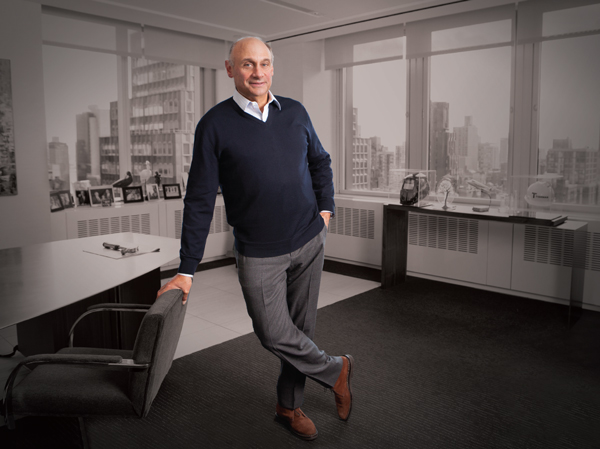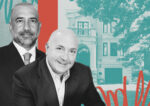Trending
Deconstructing Tishman
Dan Tishman is one of the construction industry’s leading men, but his close ties</br> to the governor have sparked</br> pushback from critics

As a handful of real estate bigwigs arrived on the 64th floor of One World Trade Center to hear Gov. Andrew Cuomo give his State of the State address — one of several such speeches he delivered throughout New York in January — none seemed particularly absorbed by the building’s panoramic views.
Among them was Dan Tishman, the tower’s construction manager and a fourth-generation member of one of the most prominent real estate dynasties in New York City. He quickly joined up with Bill Rudin and Pat Foye, executive director of the Port Authority of New York and New Jersey. Tishman has worked extensively with the bi-state agency on the rebuilding of the World Trade Center and, most recently, on the master plan for the redevelopment of LaGuardia and John F. Kennedy International airports. The three chatted quietly as other guests milled around, waiting for the governor to arrive.
As someone who has worked on some of the city’s biggest commercial real estate developments, Tishman, 61, is tapped into various spheres of influence, including Albany. He’s become a go-to consultant for major infrastructure initiatives in the state and a trusted expert developers repeatedly turn to for guidance on projects and the market at large.
“Most of the large developers are people who I have done business with and know,” the construction boss said in an interview with The Real Deal earlier this year. “My role, principally, is client relations.”
Tishman, who serves as vice chairman and a board member at AECOM, is now the key go-between for the multinational engineering giant and its clients. The publicly traded Los Angeles-based firm acquired his family’s company, Tishman Construction, seven years ago and renamed it AECOM Tishman.
But while Tishman’s government and real estate connections are a major boon to AECOM as it grows its construction outfit and takes on larger projects, his close ties to Cuomo have drawn criticism on more than one occasion. His political alliances also have dragged him into the ongoing feud between Albany and City Hall and sparked accusations of pay-to-play.
Of course, being a major political contributor or having personal ties to a high-level politician doesn’t necessarily mean that an individual or company receives special favors. Yet John Kaehny, executive director of watchdog group Reinvent Albany, noted that situations like these — where a major contributor’s company snags big public contracts — are endemic in the state, largely due to its lack of a pay-to-play law.
“It’s no doubt that you want the governor to be your friend rather than an enemy if you’re competing for a big contract,” he said.
Kaehny referred to Tishman as an “active participant” in New York’s pay-to-play culture, but emphasized that he would be more of an exception if he weren’t. The industry scion, he also noted, is a “large contributor, but not the largest.”
Friends in high places
At an Empire State Development meeting in May 2016, a city official called into question Tishman’s ties with the governor. The incident occurred moments before AECOM Tishman was awarded two small contracts totaling just over $8 million for planning and preconstruction work at the Jacob K. Javits Center to prepare it for a $1 billion-plus overhaul.
The construction company couldn’t outright bid on the Javits expansion, since it was part of the original team that built the convention center in the 1980s. But Tishman’s involvement quickly became a proxy for the battle between the governor and mayor.

A rendering of the renovated LaGuardia Airport
Peter Wertheim, an ESD board member and advisor to Deputy Mayor Alicia Glen, noted that the company already has a role in the project and that Tishman is one of Cuomo’s top donors. Tishman and his wife, Sheryl, have given $323,625 to the governor since 2007. Wertheim noted that ESD had halted a city-run project at Brooklyn Bridge Park just days before the meeting over concerns that the developer donated to Mayor Bill de Blasio.
“To me, it feels interesting to sit here and be asked to vote on an $8 million contract for one of the governor’s largest donors,” Wertheim said at the time. “This whole process to me is feeling like there’s a lot of subjectivity in how decisions are being made.”
Nearly a year later, ESD approved increasing the Javits contract to $95 million, in order to upgrade AECOM Tishman’s role on the project to the construction manager at risk, which means the company will oversee the project’s various subcontractors. Wertheim didn’t speak out against the contract in that meeting.
While NYC has its own pay-to-pay law — which restricts campaign donations to $400 for companies and individuals who have business before the city — without such legislation at the state level, separating a perceived conflict of interest from an actual one is nearly impossible, Kaehny said.
“We don’t know, and we can’t know,” he explained. “You can’t tell the difference between a bribe versus just an everyday contribution from someone who wants to show support for someone who they think is great.”
An attorney for ESD asserted at the time of the May 2016 incident that Tishman was removed from any communications involving the Javits expansion to “avoid even the appearance of impropriety.” Wertheim declined to comment when contacted in April and a spokesperson for Cuomo said, “No contribution of any size will influence a government action, period.”
Tishman dismissed the incident during his interview with TRD, noting that his involvement with the Javits Center predated Cuomo’s administration. He said his construction company was selected due to its institutional knowledge of the facility and not because he’s friends with the governor.
“These things happen. I’m pretty thick-skinned,” he said. “That was an unfortunate thing from a person who works for the city, who was completely out of line and uneducated.”
Tishman’s ties to Cuomo stem, in part, from the fact that their fathers were friends and had traveled together in the 1980s.
“We don’t vacation together, but he has no issues calling me, and I have no issues calling him,” he said. “And I’m happy that he can call me and say, ‘Listen, Dan, I need some help on infrastructure.’”
Projects the two have worked on together include the reconstruction of the Tappan Zee Bridge and the redesign and rehabilitation of the city’s airports. In January 2015, Cuomo tapped Tishman to chair a panel charged with creating a master plan for LaGuardia and JFK. Officials broke ground on the $4 billion overhaul of LaGuardia in June, and the governor unveiled the panel’s plans for JFK this January.
The redevelopment, which includes expanding and redesigning terminals as well as redesigning major roads leading to the airport, is expected to cost $10 billion. Tishman said he’s drawn to these complex public projects — despite their innate controversy — because he enjoys the challenge of tackling large-scale developments that tend to intimidate others. Those projects offer a chance to show that he can envision a solution where others can’t, he added.
“Often in these kinds of exercises, you do a lot of work and it’s caught in a back drawer somewhere,” Tishman explained. “This is actually happening.”
All in the family
Tishman and his wife live in Westchester and have two adult sons. The older son, Josh, 25, is a professional horseback rider. Gabe, 20, has expressed interest in the family business but is still in college.
The Tishman family’s roots in New York City real estate date back to when Julius Tishman, a Jewish immigrant from Poland, founded Tishman Construction in 1898. His grandson John Tishman, however, is largely credited with building the company into an empire — one that constructed the original World Trade Center towers, Madison Square Garden and Disney World’s Epcot Center in Orlando, Florida.
Dan Tishman, a second cousin of developer Rob Speyer, grew up in an apartment on Park Avenue on Manhattan’s Upper East Side that his family built in the late 1940s. He attended Evergreen State College in Washington State, where he majored in wildlife ecology.
After pursuing a career in environmental science, he joined the family business in 1990 and took over as head of its Northeast operations in 1994. Then, after completing several high-profile projects, including 4 Times Square and 1 Bryant Park, he decided to sell the company to AECOM for $245 million. That deal closed in July 2010.
Tishman said his family’s business was competing with large multinational public companies at the time and needed to either expand or merge with an existing firm to compete.
“We had actually really tapped out our opportunities in the U.S. We had great coverage, we did lots of work,” he said. “As so often happens, if you’re big, you sort of have to become bigger.”
Tishman still separately runs Tishman Realty, a development and property-management firm that oversees more than $4 billion in assets. The company’s office is in the same building as AECOM Tishman at 100 Park Avenue, located 13 floors higher.
At the time of the acquisition, AECOM had 48,100 employees and brought in $6.5 billion in revenue. Since then, its workforce has swelled to 87,000 employees, while the company brought in $17.4 billion in revenue during fiscal year 2016, per SEC filings.
The engineering firm frequently works as a general partner on developments, typically investing $10 million to $30 million. Under that arrangement, Tishman is often guaranteed to serve as a construction manager on those projects.
“Anybody who’s developing a building over a billion dollars is risking their career over that project,” said Daniel McQuade, group president of construction services at AECOM. “In all those cases, those people have a high level of comfort with Dan.”
At the same time, Tishman has stayed active in environmental causes and has chaired the Natural Resources Defense Council, a New York-based activist organization, since 2007. The group’s website is currently seeking donations to “Save the EPA” and “Stop the Trump Sellout.”
He was reluctant to speak in depth about the president, though his political donations lean left. He gave $33,400 to Hillary Clinton’s political action committee, the Hillary Victory Fund, in 2015. He also noted that he has not yet seen a plan for how Trump going to deliver on a $1 trillion investment in infrastructure.
“There is no plan,” Tishman said. “Those types of things can get very caught up in politics. It’s one thing to say we’re going to spend a trillion dollars on infrastructure, which I would love. It’s another thing to describe how you’re going to get the money to spend the trillion dollars.”
The great intermediary
For AECOM Tishman, which is involved in several large projects around the city — among them, SL Green’s $1 billion One Vanderbilt high-rise — Tishman has increasingly taken on a liaison role. His connections and institutional knowledge, in part, come from several generations of success in the business, according to several developers he’s worked with.
Related Companies President Bruce Beal said he and Steve Ross brought on Tishman after temporarily halting construction at MiMa, the 1.2 million-square-foot mixed-use tower at 450 West 42nd Street, in 2008. They both knew Tishman but had never actually worked with him. After that, they brought him on as a consultant at Hudson Yards. The company, now working with AECOM Tishman, is building its 2.6-million-square-foot office tower at 30 Hudson Yards. Beal said he periodically calls Tishman to ask for advice about the market and other industry issues.
All the developers who spoke to TRD referred to Tishman as someone who knows how to handle a crisis. Douglas Durst recounted that Tishman and his team worked “day and night” to secure 4 Times Square after a temporary elevator tower collapsed at the site in 1998, killing an 85-year-old woman. And RXR Realty’s Scott Rechler, who worked with Tishman on the WTC memorial while serving on the Port Authority, said the construction boss was able to calmly tackle the complex and controversial project.
“He doesn’t get caught up in anything theoretical,” Rechler said. “He wants to find a way to get it done.”
Larry Silverstein noted that after 9/11, he almost immediately called John Tishman to ask if he’d help in the rebuilding efforts. But the elder Tishman suggested that Silverstein instead work with his son, starting with the rebuilding of 7 World Trade Center. Silverstein went on to enlist Tishman to help construct towers 3 and 4 and said there’s a good chance he will also ask him to work on 2 WTC — once the project gets moving again.
“It’s a difficult business,” Silverstein said. “There are all kinds of risks you encounter on a daily basis. Dan, I found, was the consummate contractor. He was extremely knowledgeable.”
On the other hand, those risks have led to the company being held responsible for accidents and controversial hiring practices at its job sites. In November 2014, a worker who fell off a scaffolding at 3 World Trade Center sued AECOM Tishman and the Port Authority. The case is still pending.
In March 2016, AECOM Tishman was saddled with an “integrity monitor” to oversee the company’s “substantial ongoing contracts with the Port Authority.” The agency voted to require the monitor in response to a deferred prosecution agreement the company reached with federal prosecutors in December 2015. In that case, AECOM Tishman was accused of overbilling the Port Authority for its work on projects including One World Trade Center, the WTC PATH Hub and the Javits Center. Through the deferred prosecution agreement, AECOM Tishman agreed to pay $20 million in restitution.
Over the last six years, Tishman has also been embroiled in a legal dispute with the Bronx-based nonprofit United Hispanic Construction Workers. AECOM Tishman and SL Green lobbed a lawsuit at the group in 2011, accusing its members of harassing and intimidating employees at Tishman’s Park Avenue office. The group was protesting the lack of diversity on the company’s worksites.
“Tishman Construction works in the neighborhoods that we live in and doesn’t employ the people from the neighborhood,” David Rodriguez, president of UHCW, told TRD at the time.
Sometimes the company is pitted against forces that are out of its control and projects simply “crater,” Tishman explained. This was the case for the Access to the Region’s Core project — a proposed tunnel under the Hudson River linking New Jersey and New York. AECOM Tishman was supposed to be part of the construction management team, but New Jersey Gov. Chris Christie canceled the project in 2010, citing a lack of funds.
Tishman also noted that the new World Trade Center went through several different political administrations and Port Authority directors and occasionally seemed at the point of falling apart, largely due to political tensions.
“The risk that many of these projects face is that when it gets out of the design-construction phase and gets into the political world, it’s usually the death knell,” he said. “I try to stay pretty unaffected by politics. I’m not afraid to render my opinion on how things should be done.”




